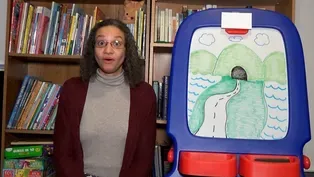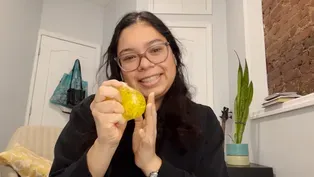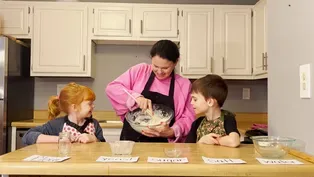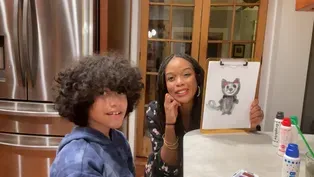
SELF-PORTRAITS
Clip: 5/5/2023 | 9m 42sVideo has Audio Description, Closed Captions
Katherine Huala and Belinda Blum from Studio in a School create self-portraits.
Katherine Huala and Belinda Blum from Studio in a School create self-portraits. Using a mirror, they notice the shapes and features of their faces, then draw and paint what they see.
See all videos with Audio DescriptionADProblems with Closed Captions? Closed Captioning Feedback
Problems with Closed Captions? Closed Captioning Feedback
Let's Learn is a local public television program presented by THIRTEEN PBS

SELF-PORTRAITS
Clip: 5/5/2023 | 9m 42sVideo has Audio Description, Closed Captions
Katherine Huala and Belinda Blum from Studio in a School create self-portraits. Using a mirror, they notice the shapes and features of their faces, then draw and paint what they see.
See all videos with Audio DescriptionADProblems with Closed Captions? Closed Captioning Feedback
How to Watch Let's Learn
Let's Learn is available to stream on pbs.org and the free PBS App, available on iPhone, Apple TV, Android TV, Android smartphones, Amazon Fire TV, Amazon Fire Tablet, Roku, Samsung Smart TV, and Vizio.
Providing Support for PBS.org
Learn Moreabout PBS online sponsorship[upbeat music] - Hello, artists, my name is Katherine.
- My name is Belinda.
- Today we're going to be making a special kind of artwork called a self-portrait.
- Katherine, what is a self-portrait?
- A self-portrait is an artwork that an artist makes about themselves.
- That sounds fun, I want to make one too.
- Okay, let's get started, but first, let's look over our materials.
Today we're going to be using oil pastels, or a crayon or pencil to draw our portrait, watercolor paint, a paintbrush, water, watercolor paper, and a mirror.
You can look in a mirror before you start drawing your self-portrait, or you can keep one nearby, so you can look as you work.
To get started, I'm gonna choose a brown and blue oil pastel to draw the lines and shapes, then I'll add color later.
First, I'm going to draw the biggest shape, the shape of my head.
I'm going to feel the shape with my hands, I feel an oval.
What shape do you feel?
Is your oval longer, shorter, or a little bit lighter?
I notice that the top of my head by my forehead is wider.
Now let's go to the chin.
That's a lot smaller.
I'm gonna keep this in mind as I draw my self-portrait.
I'm gonna begin my drawing with very light lines, that way I can make changes as I go along.
Also going to make my oval nice and big, that way I can fit in all the facial features.
I'm gonna make it a little bit darker.
[playful music] Next, I'm going to add the two lines for the neck.
Next, we're going to draw the different parts of our face.
Let's begin with the eyes.
Let's gently feel the shape of our eyes.
Go all the way around.
This also feels like an oval except it's smaller, and I noticed that it's pointier on both ends.
I'm gonna leave some space for my forehead and draw the eyes.
My eyes are of curved oval.
One.
And then I'll draw a second.
Nice and slowly, so I can draw everything that I felt.
Okay, our eyes have a small circle shape inside of them, that's the iris.
I'll draw the iris next.
Above our eyes, our eyebrows, let's take a feel.
Gently feel the shape of your eyebrows.
I feel an oval, it's longer, little thinner, and this time it's going down.
[playful music] It's time to draw our nose.
Our nose is right in the middle of our face, in between our eyes.
Pick up your fingers once again, and let's feel our nose together.
Notice that the top of my nose is thinner, and as I walk my fingers down, it gets wider.
It's like a triangle shape.
Hmm.
Except the corners on the bottom are little curves.
[upbeat music] - Katherine, I drew my nose, but I think I wanna make it a little bigger.
What do you do when you wanna change something?
- That's a great question, Belinda.
This happens to artists all the time.
You can try drawing right over it.
- Like this?
[upbeat music] - Great problem-solving, Belinda.
- Thanks.
- Now I'm going to add my mouth to my self-portrait.
Let's take a feel.
Gently trace the shape of your mouth.
It's also a pointy oval pointing downward.
But what if I open my mouth like this?
Hmm, it changes.
I think I'm gonna take a look at the shape of my mouth with my mirror.
[upbeat music] What feeling does that show?
I looked surprised.
Hmm.
We can show different feelings when we have our mouth closed.
Let's try it out.
What if I do this with my face?
What feeling am I showing?
I think I'm gonna draw my mouth surprised.
Belinda, what kind of feeling are you gonna show in your self-portrait?
- I'm gonna draw a curved line to show a happy feeling.
- Okay, that sounds great.
I'm going to continue drawing slowly.
[upbeat music] Next, I'm going to add the shapes on the outside of my face.
Let's begin with the ears.
The shape of my ear feels curved.
[upbeat music] Hmm.
What else is on the outside of our head?
Hair.
I'm going to draw a bumpy shape to draw my hair.
Bump, bump, bump, bump, bump, bump, bump.
[playful music] First I'm gonna make some dark lines, and then I'm gonna add some lighter lines in between.
[playful music] [playful music] - I am gonna draw some curly lines to make my hair.
[playful music] - You can use all different kinds of lines and shapes to draw your hair.
I wonder how you'll draw it.
What details can we add to show more about who we are?
Hmm.
I think I'm gonna try the eyelashes.
I also noticed that when I open my mouth wide, I could see the bottom of my teeth.
I'm gonna add that detail as well.
What details will you add to your self-portrait?
Okay, I think we're done, Belinda.
What do you think of mine?
- It looks great.
I noticed the details you've added: the teeth, and the eyelashes.
- Thank you, Belinda.
I tried to go slowly and draw every shape that I felt.
What details did you add to yours?
- [Belinda] I added earrings.
- I noticed that you used curly lines to show your hair.
- Yes, I did.
I wonder how we can add color to our portraits?
- That's a good idea.
We can use watercolor to finish our self-portraits.
You can do this too if you have watercolors.
You could also use any other material to add color.
To get started, we need to wake up our watercolor paint.
I'm gonna dip my paintbrush in the water, and go back and forth, and I'm gonna bring my brush to my paint.
I'm going to add the water until the paint looks a little bit shiny.
That's when I know it's ready.
[playful music] [playful music] I notice that when I put the watercolor paint on top of the oil pastel line, they push away the paint, they resist the watercolor.
[playful music] Okay, now I think I'm gonna add a little bit of color to my hair.
[playful music] [playful music] I can even paint the area around my face.
That's the background.
I am done with my self-portrait.
Belinda, did you complete yours?
- I did.
Wow, look how the color changed in your self-portrait.
- [Katherine] I chose blue for my background.
What color did you choose, Belinda?
- [Belinda] I chose green because it's my favorite color.
- I didn't know green was your favorite color.
I learned something new about you from your self-portrait.
[playful music] It's fun to share who we are in our self-portraits.
How about you?
What lines and shapes will you use to draw your self-portraits?
What special details will you add?
When you're done, you can share your self-portrait with someone and tell them about the choices you made.
Have fun, artists!
- Have fun, artists!
ADDING MAGIC E TO WORDS WITH I
Video has Audio Description, Closed Captions
Clip: 5/5/2023 | 8m 16s | Anna Scretching-Cole explains how e at the end of a word can change the vowel sound of i. (8m 16s)
Video has Audio Description, Closed Captions
Clip: 5/5/2023 | 8m 20s | Introducing Spanish words, Brenda Salazar explains how items from her home represent her. (8m 20s)
Video has Audio Description, Closed Captions
Clip: 5/5/2023 | 9m 9s | Shawn Bible’s dance students show how to move in straight, curved, and zig-zag pathways. (9m 9s)
Video has Audio Description, Closed Captions
Clip: 5/5/2023 | 34s | Jewel loves to dance. (34s)
Video has Audio Description, Closed Captions
Clip: 5/5/2023 | 10m 7s | Cassondra Easterling and her children show how to make bread. (10m 7s)
Video has Audio Description, Closed Captions
Clip: 5/5/2023 | 10m 20s | Maria Begg-Roberson reads PERFECT PARTNERS by Mary Amato, illustrated by Kashin Kheiriyeh. (10m 20s)
Providing Support for PBS.org
Learn Moreabout PBS online sponsorshipSupport for PBS provided by:
Let's Learn is a local public television program presented by THIRTEEN PBS

















